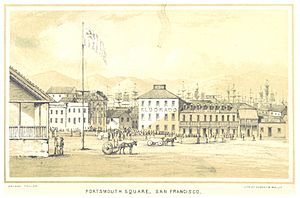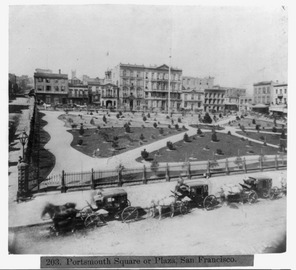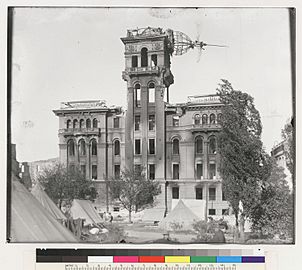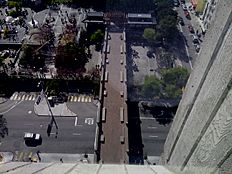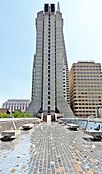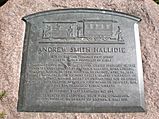Portsmouth Square facts for kids
Quick facts for kids Portsmouth Square |
|
|---|---|
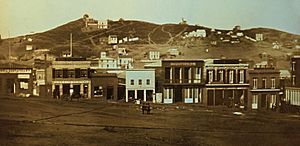
Portsmouth Square, looking north to Telegraph Hill, 1851.
|
|
| Location | Chinatown, San Francisco, California |
| Area | 57,516 sq ft (5,343.4 m2) |
| Created | 1833 |
| Reference no. |
|
Portsmouth Square (traditional Chinese: 花園角; simplified Chinese: 花园角; Mandarin Pinyin: Huāyuán jiǎo; Jyutping: Faa1jyun4 Gok3), also known as Portsmouth Plaza, is a historic park in Chinatown, San Francisco, California. It covers about 57,516 sq ft (5,343.4 m2), which is roughly the size of one city block. The park is surrounded by Kearny Street to the east, Washington Street to the north, Clay Street to the south, and Walter Lum Place to the west.
Contents
Portsmouth Square: A Historic City Park
The Park's Early Beginnings
Portsmouth Square is built on the site of the very first public square in the area. This square was created in the early 1800s when the area was a Mexican community called Yerba Buena. People started using this spot for gatherings in 1833. By 1835, it was officially recognized as a plaza.
In 1839, a surveyor named Jean Jacques Vioget mapped out the settlement. He designed a grid of streets around the plaza, which overlooked the nearby cove.
In 1844, the Mexican government built a custom house on the northwest side of the plaza. During the Mexican–American War, Captain John Berrien Montgomery of the USS Portsmouth was ordered to take control of Yerba Buena. On July 9, 1846, Captain Montgomery and 17 men landed. They raised the first American flag near the Mexican custom house. Later that year, the plaza was named Portsmouth Square to honor his ship. In 1847, the settlement's name was changed to San Francisco.
Many important historical events have taken place at Portsmouth Square:
- In 1847, the first public school in California was built at the southwest corner of the plaza.
- On May 11, 1848, the exciting news of the discovery of gold was announced here. Sam Brannan showed off his gold to a large crowd.
- On June 12, 1849, people gathered at the plaza to demand elections for delegates. These delegates would attend the Monterey Constitutional Convention.
- An assembly was held on July 16, 1849, to stand up against a group called 'The Hounds'.
- On August 29, 1850, a special service was held after the death of U.S. President Zachary Taylor.
- The first Admission Day celebration happened on October 29, 1850. This was when California officially became the 31st state of the United States.
- On June 1, 1852, a crowd protested against the city buying the Jenny Lind Theatre to use as a city hall.
- On September 18, 1859, Colonel E. D. Baker gave a speech. This was after U.S. Senator David C. Broderick was killed in a duel.
Changes to the Park Over Time
-
The Hall of Justice after the 1906 San Francisco earthquake and fire.
In the 1860s, the park was designed with paved paths. These paths spread out from the center, creating wedge-shaped grassy areas. Trees were planted and grew tall. By the 1880s, the growing Chinese American community began calling the Square Fa Yuhn Gok, which means "the garden corner." By 1905, many trees had been removed. The Robert Louis Stevenson Memorial, built in 1897, became a main feature in the park's center.
During the 1906 San Francisco earthquake and fire, Portsmouth Square was again a gathering place. It became a temporary tent city for people who lost their homes. It was also used as a temporary burial site. In the late 1920s, the site was renamed Portsmouth Plaza.
Building the Underground Garage
In 1959, the San Francisco Board of Supervisors approved building a parking garage under Portsmouth Square. Many people did not want this to happen. Construction on the Portsmouth Square Garage started in 1961. This project required the entire park to be removed and rebuilt. The garage was finished in 1963.
The garage has four levels and can hold 500 cars. It goes down about 26 feet (7.9 m) below Kearny Street. About 1500 vehicles use the garage every day.
In the late 1960s, a new hotel (now the Hilton San Francisco Financial District) was built. A bridge was added across Kearny Street to connect the new hotel with the park. This bridge was completed in 1970. The park's playground was also made larger around 1971–72.
Modern Renovations
In 1987, the park went through its second major renovation. This project happened in three stages. The first stage added new elevators and bathrooms to the park. The second stage began in 1994. It included new play structures for children, Chinese chess tables, benches, and new plants. The third stage involved building a new community room and more play areas. This $3.9 million renovation was finished in 2001, and the park reopened to the public.
Portsmouth Square Today
Portsmouth Square is often called the "Heart" or "Living Room" of Chinatown. It is a very important place for local residents. People come here to play games, practice tai chi, and spend time with friends and family.
The San Francisco Planning Department has started a project to improve Portsmouth Square and the streets around it. They want to make the space even better for everyone who uses it.
Park Design and Special Features
An underground parking garage with four levels is located beneath Portsmouth Square.
Historical Markers and Statues
The park has many important markers and statues. Three of these are registered as California Historical Landmarks:
- #119 (placed 1924): Honors the first time the American flag was raised in the square in 1846.
- #500 (1953): Marks the eastern end of the first Clay Street Hill Railroad Company, which was a cable car system.
- #587 (1957): Celebrates the opening of California's first public school in 1848.
The Robert Louis Stevenson Memorial is also in the park. It was designed by Bruce Porter and Willis Polk. It has a bronze ship sculpture by George Piper. This memorial was put up in 1897.
You can also find a statue of the Goddess of Democracy in the park. This statue was a gift to the city. It remembers the 1989 Tiananmen Square Protests.
The Tot Lot Playground
The playground at Portsmouth Square has a special art installation called Tot Lot. It was created by Mary Fuller and Robert McChesney. These sculptures are made of concrete and glass. They are used as playground equipment, like a slide and a sandbox.
The Tot Lot was finished in 1983 and opened in 1984. It features six animals from the Chinese zodiac: a Goat, a Tiger, a Monkey, a Rabbit, a Dragon, and a Snake. All the animals have glass eyes and have an abstract design. Children love to play on these unique sculptures.
Portsmouth Square in Movies
Director Don Siegal filmed a scene from his 1971 movie Dirty Harry in Portsmouth Square. In the movie, as the character "Dirty Harry" follows "Scorpio," you can see the stone bridge. This bridge connects the park to the Chinese Culture Center of San Francisco.
See also
 In Spanish: Plaza Portsmouth para niños
In Spanish: Plaza Portsmouth para niños



